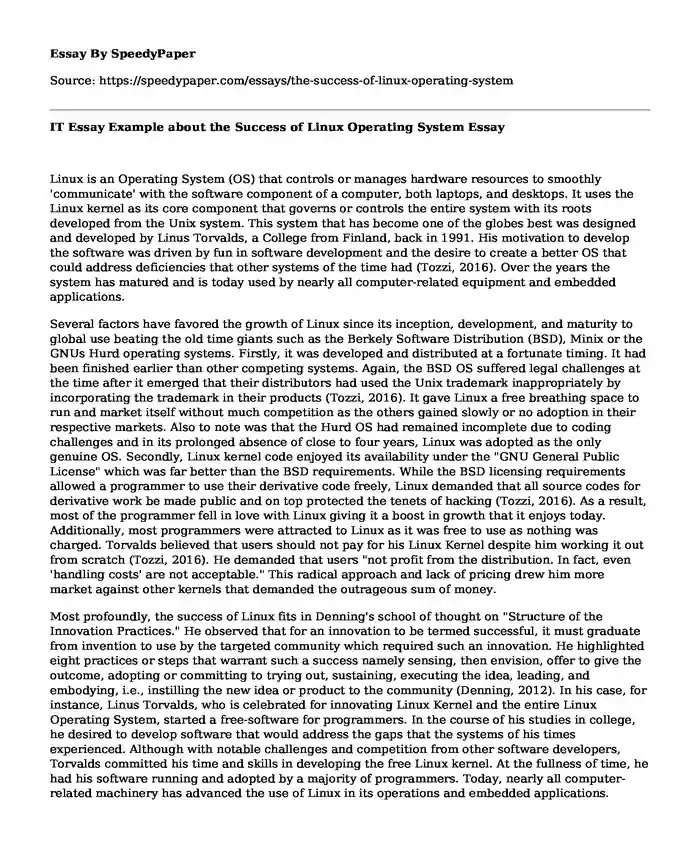Linux is an Operating System (OS) that controls or manages hardware resources to smoothly 'communicate' with the software component of a computer, both laptops, and desktops. It uses the Linux kernel as its core component that governs or controls the entire system with its roots developed from the Unix system. This system that has become one of the globes best was designed and developed by Linus Torvalds, a College from Finland, back in 1991. His motivation to develop the software was driven by fun in software development and the desire to create a better OS that could address deficiencies that other systems of the time had (Tozzi, 2016). Over the years the system has matured and is today used by nearly all computer-related equipment and embedded applications.
Several factors have favored the growth of Linux since its inception, development, and maturity to global use beating the old time giants such as the Berkely Software Distribution (BSD), Minix or the GNUs Hurd operating systems. Firstly, it was developed and distributed at a fortunate timing. It had been finished earlier than other competing systems. Again, the BSD OS suffered legal challenges at the time after it emerged that their distributors had used the Unix trademark inappropriately by incorporating the trademark in their products (Tozzi, 2016). It gave Linux a free breathing space to run and market itself without much competition as the others gained slowly or no adoption in their respective markets. Also to note was that the Hurd OS had remained incomplete due to coding challenges and in its prolonged absence of close to four years, Linux was adopted as the only genuine OS. Secondly, Linux kernel code enjoyed its availability under the "GNU General Public License" which was far better than the BSD requirements. While the BSD licensing requirements allowed a programmer to use their derivative code freely, Linux demanded that all source codes for derivative work be made public and on top protected the tenets of hacking (Tozzi, 2016). As a result, most of the programmer fell in love with Linux giving it a boost in growth that it enjoys today. Additionally, most programmers were attracted to Linux as it was free to use as nothing was charged. Torvalds believed that users should not pay for his Linux Kernel despite him working it out from scratch (Tozzi, 2016). He demanded that users "not profit from the distribution. In fact, even 'handling costs' are not acceptable." This radical approach and lack of pricing drew him more market against other kernels that demanded the outrageous sum of money.
Most profoundly, the success of Linux fits in Denning's school of thought on "Structure of the Innovation Practices." He observed that for an innovation to be termed successful, it must graduate from invention to use by the targeted community which required such an innovation. He highlighted eight practices or steps that warrant such a success namely sensing, then envision, offer to give the outcome, adopting or committing to trying out, sustaining, executing the idea, leading, and embodying, i.e., instilling the new idea or product to the community (Denning, 2012). In his case, for instance, Linus Torvalds, who is celebrated for innovating Linux Kernel and the entire Linux Operating System, started a free-software for programmers. In the course of his studies in college, he desired to develop software that would address the gaps that the systems of his times experienced. Although with notable challenges and competition from other software developers, Torvalds committed his time and skills in developing the free Linux kernel. At the fullness of time, he had his software running and adopted by a majority of programmers. Today, nearly all computer- related machinery has advanced the use of Linux in its operations and embedded applications.
Conclusively, the Linux Operating System is one of the best with a friendly user interface easy to use and operate on. Torvalds meets the criteria of an innovative guru who has transformed the world with his free kernel software.
References
Denning, P. J. (2012). Innovating the future: From ideas to adoption. The Futurist, 46(1), 40.
Tozzi, C. (2016, March 29). Linux at 25: Why It Flourished While Others Fizzled. Retrieved from https://spectrum.ieee.org/tech-history/cyberspace/linux-at-25-why-it-flourished-while-others-fizzled
Cite this page
IT Essay Example about the Success of Linux Operating System. (2022, Apr 07). Retrieved from https://speedypaper.net/essays/the-success-of-linux-operating-system
Request Removal
If you are the original author of this essay and no longer wish to have it published on the SpeedyPaper website, please click below to request its removal:
- Free Essay Sample: Consequences of Internet
- Free Essay on the Rate of Imprisonment in America
- Essay Sample on Globalization Research
- Free Essay: Women and Sports in the US
- Essay Example on Cell Phones and Brain Tumors
- Free Essay Sample: Uniforms Should Be Allowed in Public Schools
- Thesis Proposal Sample on the Theme of Open Exchange
Popular categories





